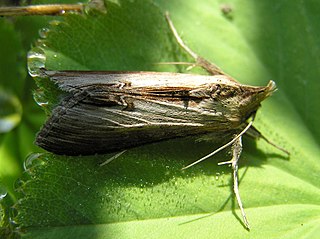
Lithophane leautieri, the Blair's shoulder-knot, is a moth of the family Noctuidae. It is found in Europe. It originated from the area surrounding the Mediterranean Sea, but gradually moved north.

Cucullia asteris, or star-wort, is a moth of the family Noctuidae. The species was first described by Michael Denis and Ignaz Schiffermüller in 1775. It is found through the Palearctic including Japan.

Schrankia costaestrigalis, the pinion-streaked snout, is a species of moth of the family Erebidae. It is found in Europe, the Canaries, Madeira, Syria, Armenia. It is also present in New Zealand. The species closely resembles Crambidae or Pyralidae species.

Dypterygia scabriuscula, the bird’s wing, is a moth of the family Noctuidae. The species can be found in Europe and the western Palearctic.

Conistra rubiginea, the dotted chestnut, is a moth of the family Noctuidae. The species was first described by Michael Denis and Ignaz Schiffermüller in 1775. It is distributed in Europe and, according to William Warren, Armenia and Asia Minor.

Catocala nymphagoga, the oak yellow underwing, is a moth of the family Erebidae. It is found in Southern Europe, from Bulgaria up to the Iberian Peninsula and sometimes further north as a migrant. It is also found in North Africa and Asia Minor.

Mesapamea secalis, the common rustic, is a moth of the family Noctuidae. The species was first described by Carl Linnaeus in his 1758 10th edition of Systema Naturae. It is found in Europe, north-west Africa, Turkey and northern Iran.

Grammodes stolida, the geometrician, is a moth of the family Erebidae. The species was first described by Johan Christian Fabricius in 1775. It is found in Africa, southern Europe, most of Asia and Australia. It migrates to central and northern Europe as far north as England, Denmark and Finland.

Cleonymia baetica is a moth of the family Noctuidae. It is found from south-western Europe and North Africa, south-east Turkey, Iraq to southwest Iran, it is also known from Saudi Arabia, Jordan, Syria and Israel.

Jodia croceago, the orange upperwing, is a moth of the family Noctuidae. The species was first described by Michael Denis and Ignaz Schiffermüller in 1775. It is found in southern and central Europe, to the north up to the southern half of England and Wales. According to Warren. W. in Seitz, A. Ed., 1914 also in Algeria, Asia Minor, and Armenia.

Hyppa rectilinea, the Saxon, is a moth of the family Noctuidae. It is found in Europe, but mostly in northern and central Europe. In the south, it is found in scattered populations, mainly in mountainous areas. To the east, its range stretches through the Palearctic and eastern Siberia, up to the Pacific Ocean and Japan.

Lithophane socia, the pale pinion, is a moth of the family Noctuidae. The species was first described by Johann Siegfried Hufnagel in 1766. It is found throughout western Europe from Spain to central Scandinavia then east across the Palearctic to Siberia, the Russian Far East and Japan.

Actinotia polyodon, the purple cloud, is a moth of the family Noctuidae. It is found in much of the Palearctic realm, from Europe to Russia and Japan.

Lithophane lamda, the nonconformist, is a moth of the family Noctuidae. It is found throughout Europe, except in southern Europe. It is also absent from Iceland and Ireland.

Shargacucullia prenanthis, the false water betony, is a moth of the family Noctuidae. It is found from south-eastern France, through the Alps and bordering mountains east to Romania and Bulgaria. It is also found in Anatolia and Lebanon.

Meganephria bimaculosa, the double-spot brocade, is a species of moth of the family Noctuidae. It is found in most of Europe, in Turkey and the west of Iran. In Anatolia it is represented by the subspecies Meganephria bimaculosa pontica.

Condica capensis is a moth of the family Noctuidae. It is found across Africa, the Indian sub-continent and South-East Asia. In Europe, it is only common in southern Spain, but can be found further north.

Lithophane furcifera, the conformist, is a moth of the family Noctuidae. The species was first described by Johann Siegfried Hufnagel in 1766. It is found from central Europe, east to the Black Sea region, the Caucasus and western Siberia. In the mountains, it is found up to elevations of 1,800 meters.

Callopistria latreillei, Latreille's Latin, is a moth of the family Noctuidae. The species can be found in the Palearctic realm, most parts of Europe, Asia, and in Africa from Egypt to South Africa. The habitat consists of rocky limestone slopes with deciduous woodland.

Archanara neurica, the white-mantled wainscot, is a nocturnal moth of the family Noctuidae described by Jacob Hübner in 1808. It is found in Austria, Belgium, Bosnia and Herzegovina, Great Britain, Bulgaria, Croatia, the Czech Republic, Denmark, France, Germany, Hungary, Italy, Latvia, Liechtenstein, North Macedonia, Poland, Romania, Sicily, Slovakia, Slovenia, Switzerland, the Netherlands and Serbia. In the UK, its only regular sites are at RSPB Minsmere and Walberswick National Nature Reserve in Suffolk.





















